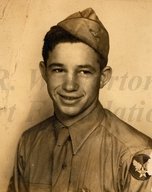
|

|
|
|
|
"Rudy" as his friends call him, was born in El Dorado, Arkansas. "We were oil field trash," he quips. Rudy lived in Louisiana towns of Myra and Hosston before his father, Loma, an oil field worker, moved the family to Oklahoma. Rudy graduated from a barber college in Oklahoma, and worked in that state in Earlsboro and then in Oklahoma City. Loma and Rudy's mother, Clarice Pendarvis, later divorced, with his mother going to live with a twin sister in Texas. "Dad kept me," he says, but later Rudy lived with his grandparents, Ashley and Margaret Thigpen, in Hosston. He finished Hosston High School in 1941, and then worked on a pipeline that summer. He was attending Southeastern, a college in Hammond, Louisiana in the fall of 1941 when Pearl Harbor was attacked. "I think it was shock that anybody would be so dumb as to do something like that," he recalls of the attack. He enlisted in Shreveport in the U.S. Army Air Forces with two buddies from Hosston. After basic training he was sent to aerial gunnery school at Fort Myers, Florida. By June of 1943, Rudy was sent to England as a B-17 ball turret gunner, based at Bassenbourne Air Force Base in England. He was ordered into the Ninety-First Bombardment Group, 322nd Bombardment Squad. His pilot aboard "Frisco Jenny" was Jack Hargis. On his third mission the pilot had to ditch the bomber in the North Sea. All got out into life rafts and were rescued after sixteen hours afloat. He was wounded on his fourth mission, August 12, 1943. Five days later the "Frisco Jenny" was shot down and Hargis was killed. Rudy did not fly again until January 29, 1944 on a plane called "Man of War." It was shot up so badly that the crew went aboard another bomber, "Man of War II." He flew eighteen missions as a ball turret gunner, approximately ten of them before fighter escorts began accompanying the bombers. Flak tore into his plane on many missions. "The last time over Berlin the flak was so thick you could walk on it," he says. Rudy recalls an enlisted bombardier, Roy Wright, being killed by flak. Because of two stays in the hospital, Rudy's crew finished their required number of missions while he still had three more to fly. He flew as a bombardier on his last three missions aboard the "General Ike." He flew his last mission five days before D-Day. Rudy landed in Boston upon returning to America, and was sent to Miami Beach for a week of relaxation. He was finally released from duty at Picayune, Mississippi, and was in Shreveport when the war ended. Rudy married Elaine McDaniel in 1945. They would have one son, three grandchildren and one great-grandchild. He worked in a battery business, and then in 1965 joined the postal service. He retired from postal work and taught tennis for twenty-five years. Rudy's medals for service include the Distinguished Flying Cross and Purple Heart. |


